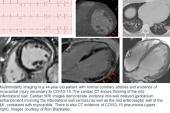ESC Releases Guidance on How to Address CVD in COVID-19 Era
As infection rates rise again, Colin Baigent hopes this two-part summary of knowledge and advice will help exhausted clinicians.

The European Society of Cardiology (ESC) has issued new, two-part guidance pertaining to cardiovascular disease during the COVID-19 pandemic.
Acknowledging the rapidly changing field, the ESC task force hopes the documents—one addressing “epidemiology, pathophysiology, and diagnosis” and the other covering “care pathways, treatment, and follow-up”—can help tired physicians manage the various manifestations of cardiovascular disease associated with the virus.
“There’s a good deal of exhaustion amongst cardiologists as well as other specialties, and I think that the message from my colleagues and myself is that we hope that the information that we provided in these pair of documents is helpful as we enter a particularly challenging period of increased infection worldwide, in Europe and also elsewhere,” writing committee co-chair Colin Baigent, FMedSci (Nuffield Department of Population Health, Oxford, England), told TCTMD.
The papers, both published yesterday in the European Heart Journal, seek to aggregate all of the available evidence and advice.
To start, the first breaks down cardiovascular conditions that are common in patients with COVID-19 as well as cardiovascular risk factors that increase the likelihood of severe COVID-19 and higher mortality. The authors also summarize the potential for myocardial injury, arrhythmias, heart failure, vascular dysfunction, and thromboembolic disease as a result of severe infection, noting that the long-term implications of these complications remain unknown.
Diagnosis is also highlighted in the first paper, with advice on what to look for upon initial clinical presentation, what tests to run and biomarkers to look at, and which imaging modalities to use. “It's particularly important to help with the recognition of the disease, so the patients with severe COVID are treated appropriately,” Baigent said.
The second paper switches gears into how clinicians should react and treat patients with confirmed COVID-19. It provides diagnostic pathways and treatment algorithms for acute and chronic coronary syndromes plus suggestions for the management of heart failure, valvular heart disease, arterial hypertension, acute pulmonary embolism, and arrhythmias.
For clinicians treating SARS-CoV-2 in patients with cardiovascular disease, the authors note the intricacies of maintaining cardiovascular medications while also looking out for drug-drug interactions, some of which may yet be unknown. Part 2 also outlines practical advice on how to reduce the risk of transmission, maintain a healthy lifestyle, and manage cardiovascular disease.
We hope that the information . . . is helpful as we enter a particularly challenging period of increased infection worldwide, in Europe and also elsewhere. Colin Baigent
“I think the most important thing here is for particular conditions, there needs to be a source of guidance on more-detailed management,” Baigent said. “If a person presents with an acute coronary syndrome in association with COVID, how is that patient to be managed? What are the priorities? What can be modified in recognition of the patient’s vulnerability and contagious nature, for example? And then, the part of practical management that is often challenging is how to look after COVID-19 while still trying to manage the cardiovascular manifestation.”
He highlighted the breadth of contributors to the publications, noting that each piece was written by content experts. “Of course, we recognize that evidence is emerging all the time and so we would emphasize that it's important for cardiologists to be as familiar as possible with the latest evidence, [although it] inevitably changes by the week,” Baigent said. “We want people to be able to build on what's been written.”
Notably, the authors stress that the documents are “not a formal guideline” but rather a summary of current knowledge and guidance.
“The recommendations are mainly the result of observations and personal experience from healthcare providers,” they say. “Therefore, the information provided here may be subject to change with increasing knowledge, evidence from prospective studies, and changes in the pandemic. Likewise, the guidance provided in the document should not interfere with recommendations provided by local and national healthcare authorities.”
Yael L. Maxwell is Senior Medical Journalist for TCTMD and Section Editor of TCTMD's Fellows Forum. She served as the inaugural…
Read Full BioSources
Baigent C, Windecker S, Andreini D, et al. European Society of Cardiology guidance for the diagnosis and management of cardiovascular disease during the COVID-19 pandemic: part 1—epidemiology, pathophysiology, and diagnosis. Eur Heart J. 2021;Epub ahead of print.
Baigent C, Windecker S, Andreini D, et al. ESC guidance for the diagnosis and management of cardiovascular disease during the COVID-19 pandemic: part 2—care pathways, treatment, and follow-up. Eur Heart J. 2021;Epub ahead of print.
Disclosures
- Baigent reports grants or contracts from the Medical Research Council, British Heart Foundation, Boehringer Ingelheim, National Institute for Health Research, He reports unpaid roles as chair of the European Society of Cardiology Clinical Practice Guidelines Committee and as vice-chair of the British Heart Foundation Clinical Studies Committee.





Comments